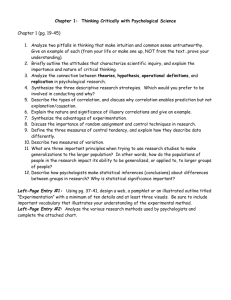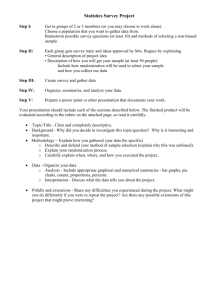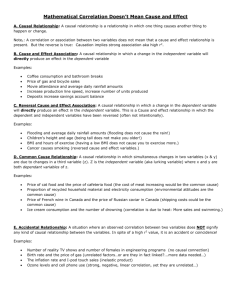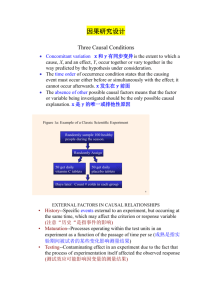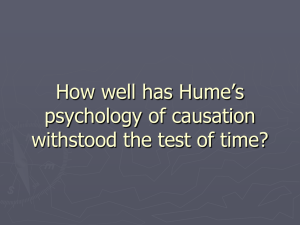lecture outline research methods
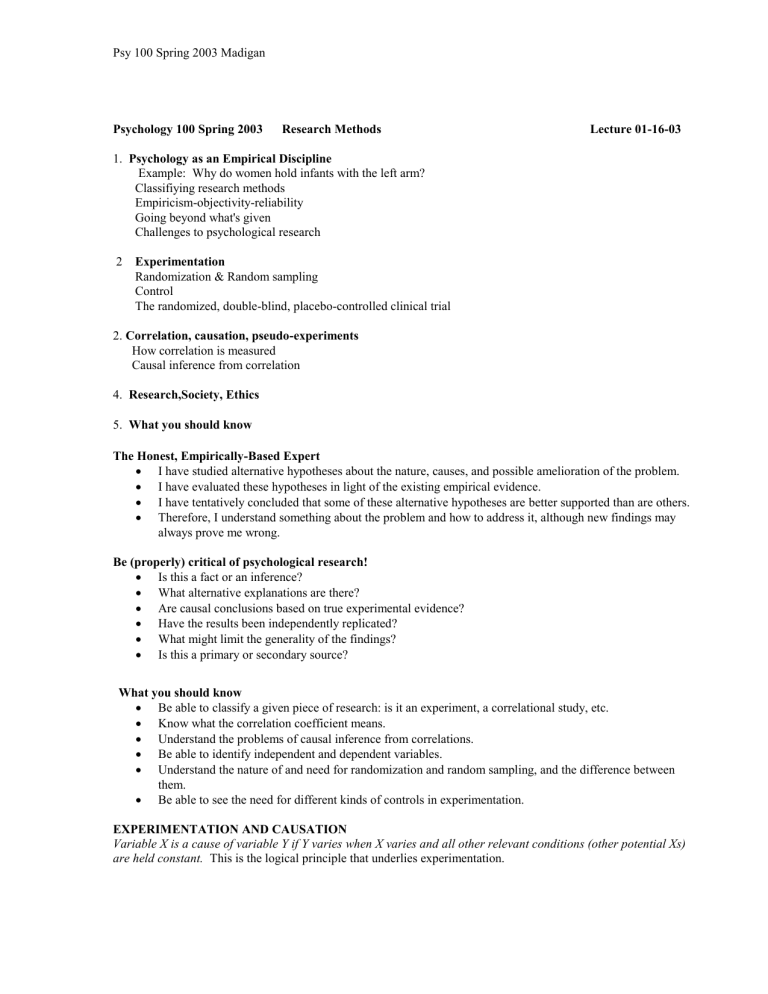
Psy 100 Spring 2003 Madigan
Psychology 100 Spring 2003 Research Methods Lecture 01-16-03
1. Psychology as an Empirical Discipline
Example: Why do women hold infants with the left arm?
Classifiying research methods
Empiricism-objectivity-reliability
Going beyond what's given
Challenges to psychological research
2 Experimentation
Randomization & Random sampling
Control
The randomized, double-blind, placebo-controlled clinical trial
2. Correlation, causation, pseudo-experiments
How correlation is measured
Causal inference from correlation
4. Research,Society, Ethics
5.
What you should know
The Honest, Empirically-Based Expert
I have studied alternative hypotheses about the nature, causes, and possible amelioration of the problem.
I have evaluated these hypotheses in light of the existing empirical evidence.
I have tentatively concluded that some of these alternative hypotheses are better supported than are others.
Therefore, I understand something about the problem and how to address it, although new findings may always prove me wrong.
Be (properly) critical of psychological research!
Is this a fact or an inference?
What alternative explanations are there?
Are causal conclusions based on true experimental evidence?
Have the results been independently replicated?
What might limit the generality of the findings?
Is this a primary or secondary source?
What you should know
Be able to classify a given piece of research: is it an experiment, a correlational study, etc.
Know what the correlation coefficient means.
Understand the problems of causal inference from correlations.
Be able to identify independent and dependent variables.
Understand the nature of and need for randomization and random sampling, and the difference between them.
Be able to see the need for different kinds of controls in experimentation.
EXPERIMENTATION AND CAUSATION
Variable X is a cause of variable Y if Y varies when X varies and all other relevant conditions (other potential Xs) are held constant. This is the logical principle that underlies experimentation.
Psy 100 Spring 2003 Madigan
THE RANDOMIZATION PRINCIPLE
When you compare an experimental group and a control group you want to be sure that the two groups don't differ systematically in any way except for the independent variable. Problem: people differ in innumerable ways that may be relevant to the dependent variable. They can't be "kept constant." Solution: random assignment. Let the outcome of a chance event (e.g., coin-toss) dictate who gets what treatment. This way, no characteristic of the people being tested systematically influences the outcome. Randomization eliminates potential biases .
RANDOM SAMPLING
Refers to how subjects are selected in the first place. Purpose: to get a sample that is representative of the populations youwant to generalize to; provides have a rational basis for making an inference from a sample to a population.
RANDOMIZED DOUBLE BLIND PLACEBO CONTROLLED CLINICAL TRIAL
This is the “gold standard” – the best method for determining the true effects of a treatment or procedure or program . Now widely used in medical research and drug studies.
Example : the effects of Paroxetine on socially avoidant behavior.
R-DB-PC-CT is an attempt to closely follow the fundamental principle of experimentation: vary one thing, keep everything else constant. Compare this to the “case-control” method: just compare people who use the drug with people who don’t . This method usually involves many sources of bias.
Example: Evaluating the effects of electro-convulsive therapy (ECT) on depression
Suppose a depressed patient is administered an ECS treatment and seems much improved later. How do you know it was the shock-convulsion that was responsible for the change? There are alternative explanations : spontaneous remission; effect of drugs administered prior to ECS; patient's expectations; doctor's expectations. You need to perform a controlled experimental evaluation . Assign depressed patients at random to one of two conditions:
Experimental Group Control Group patient sedated patient unconscious patient sedated patient unconscious electrodes attached electrodes attached current delivered
no current delivered
(or sub-critical current)
Also, have the patients evaluated by someone who is "blind" to the treatment received.
This will answer the question: is the shock-convulsion a necessary component of the treatment?
Psy 100 Spring 2003 Madigan
CAUSATION AND CORRELATION
Problem: it is often difficult or impossible to perform true experiments in psychology: a large number of variables to control; practical, legal, ethical constraints on what can be done (such as randomization). But people still want. to make causal inferences from pseudo-experiments and correlational research. Very important to understand the limitations of such research. If variables X and Y are correlated, then: (1) X is a cause of Y; or (2) Y is a cause of
X; or (3) X and Y are the effects of some third variable Z; or (4) Y is directly caused by Z and only indirectly by
